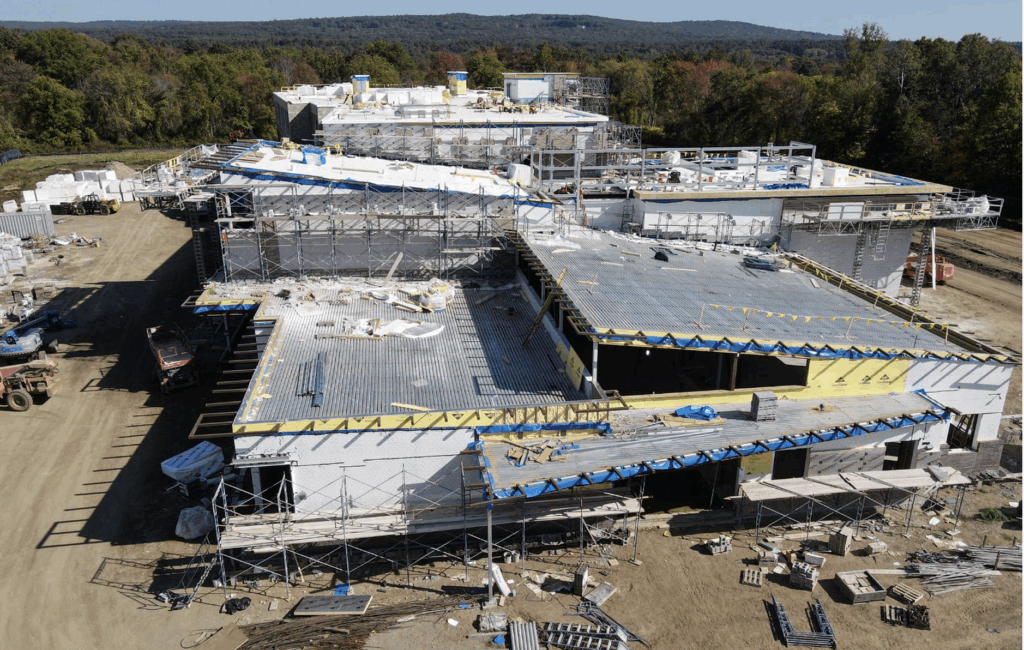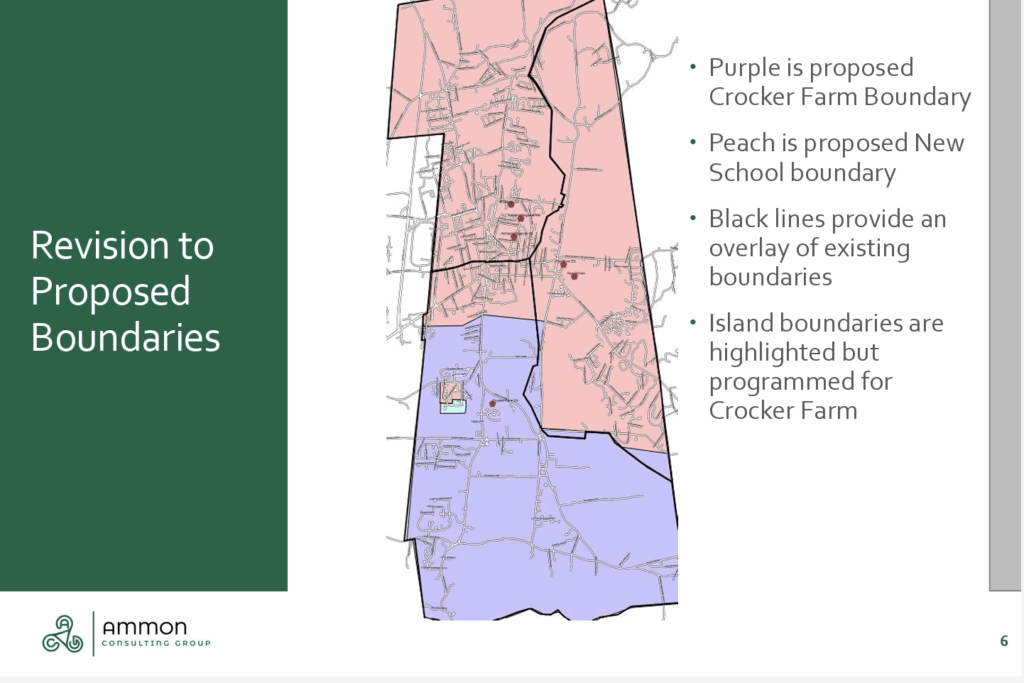School Committee Seeks Public Input on Elementary School Redistricting

The yet to be named, new elementary school, under construction at Fort River. October 2025. Photo: amherstma.gov
Report on the Special Meeting of the Amherst School Committee, October 24, 2025
This meeting was held remotely and was recorded.
Present
Jennifer Shiao (Chair), Bridget Hynes, Deb Leonard, Sarah Marshall, and Irv Rhodes
Staff: E. Xiomara Herman (Dr. Xi—Superintendent) and Shannon Bernacchia (School Finance Director)
Tim Ammon of Ammon Consulting Group presented an update on the redistricting plan for consolidating the three elementary schools into two when the new school at Fort River opens next fall, and Wildwood is closed. However, School Committee members had enough concerns regarding the proposed plan that they want more public input, although it was not decided how that input will be achieved. After hearing from the School Committee and parents at an earlier meeting, Superintendent E. Xiomara Herma (Dr. Xi) decided that established students may stay at the school they currently attend if they desire, but siblings who wish to attend the same school as older siblings will be handled on a case-by-case basis. The availability of transportation to the non-assigned school has not yet been decided.
In drawing the new districts, Ammon said he carried the projections of enrollment out 10 years, until 2036, However, he was baffled by the loss of 33 students this year, or four percent of elementary school enrollment, far more than expected, and was unsure of its implications for future enrollment. The goal of drawing the new districts was to minimize the demographic differences between the two schools and to eliminate a couple of “islands” of children attending a different school than the surrounding neighborhood because of the associated costs of both transportation and long-term administrative management of the boundaries over time.
The latest proposed boundaries vary only slightly from the previous boundaries in order to minimize the number of students who will be districted to a different school. A more detailed map will be provided to the School Committee members in the near future.

Ammon had recently received feedback from school principals about the impacts of the proposed changes on specific programs, such as self-contained special needs programs. The Pre-Kindergarten program will occupy six to eight classrooms at Crocker Farm. Two Caminantes dual-language classrooms in each grade will be located at the new school. Ammon stated that there is a difference between the physical capacity and the functional capacity of a school. Since students must be accommodated by grade, some additional students can be put in existing classrooms but, in other cases, adding a few additional students may require the creation of a new classroom. He said that the district must be judicious in allocating classrooms to allow for fluctuations in enrollment, especially if more students come back to the district with the opening of the new school.
Classroom size is aimed to be 17 to 20 students, which requires 16 classrooms at Crocker Farm and 25 at the new school. The maximum class size is 24, but in the projection, no class has more than 20 students. Dr. Xi said that, historically, more students move into the Wildwood and Fort River schools during the school year, so classes at the new school could increase to between 21 and 24 students per classroom. If students are in a special program, such as Caminantes or a special education program, the school they attend is determined by the program, not by where they live. All special programs will be located at the new school. Projections are for 292 students at Crocker Farm and 520 at the new school.
With the new boundaries, 110 students may be assigned to a different school than the one they currently attend. Marshall noted that 77 are now at Crocker Farm, and asked if all of them exercised the option to stay there, would there be room for them? Ammon said that he needs to look more carefully at that issue, but that it is a short-term problem, especially if many of those are fifth graders. Most likely, those choosing to remain at their current school would be spread out throughout the grades, so he did not think that those electing to stay at their current school would necessitate adding more than one additional classroom.
Can a Better Racial Balance Between the Schools Be Attained?
School Committee members were most concerned about the possible racial imbalance between the two schools. Sarah Marshall said that, in this plan, “The new school is significantly more white than Crocker Farm.”
Ammon said that currently Crocker Farm has 48% students who are identified as white, 16% identified as Black, 13% Hispanic, 12% multi-racial, and 10% Asian. The proposed new boundaries reduce the white students by 4% and increase the Black students by the same percentage and the Hispanic and multi-racial students by 1% each. The current population for both Wildwood and Fort River is 47% white, 14% Asian, 13% Black, 17% Hispanic, and 8% multi-racial. The proposed new boundaries increase the percentage of students identifying as white by 4%, decrease those identifying as Black or Hispanic by 3% each, and decrease the multi-racial students by 2%. About 26% of the students slated for Crocker Farm have Individual Education Programs (IEPs), as opposed to 29% slated for the new school. The percentage of English Language Learners at the two schools is projected to be the same, and those who qualify for free and reduced lunch are 37% at Crocker Farm and 36% at the new school.
Deb Leonard pointed out that the number of Black students at the new schools is projected to be nearly the same, in the mid-50’s, but the new school is nearly twice the size of Crocker Farm so that 10% of the students at the new school will be Black, but 20% of those at Crocker Farm. When asked by Elementary School Committee Chair Jennifer Shiao why Leonard thought that was a problem, Leonard replied, “Because that doesn’t feel like an equitable use of our new facility.” Irv Rhodes agreed, saying, “The percentage of African Americans at Crocker Farm is going to be over-represented, and then if you add the Hispanic or Latino population, you are going to have a percentage of people of color that are certainly over-represented. In other words, if you walk into that school, what one would conclude is that this is a school that is predominantly one of people of color.”
Dr. Xi defended the distribution of students, saying that the majority of demographic factors are within a 5% difference between the two schools, and programming was the most important factor for her. Between Wildwood and Fort River the total percentage of students identifying as people of color is 38%, while the percentage projected for the new school is 34%. She wanted to know whether the racial balance is the primary concern of the School Committee.
Marshall answered, “I know the changes have been small, but they’ve been in the direction of a whiter new school and a less white Crocker Farm. Is there some reasonable tweak to the boundaries that could better balance the racial pie chart?”
Need for Public Input Identified
None of the School Committee members wanted to create “islands” of neighborhoods to balance racial demographics, but most felt racial equity was a priority. Shiao was strongly against islands and also questioned how important demographic balance is. She appreciated that her daughter’s classroom at Crocker Farm was half children of color, and found that an asset. She advocated for more public input into the boundary creation and for additional community outreach.
Hynes stated that it is also important to balance the number of students with IEPs to maintain a ratio of one staff member for every four students. Leonard asked about how the committee would gather public information, because questionnaires are self-selective, and she wanted to be sure to obtain input from a broad cross-section of residents. Dr Xi stated that getting valid public input will require going out into the community, not holding the standard virtual meeting.
Rhodes was adamant: “We have to have a public forum. We’ve been down this road before. We don’t do it, and we are highly criticized for not being inclusive. Not to do it is not an option.” He added, “Perception matters in this town, and I’ve been through enough where controversies all of a sudden erupt because perceptions were ignored.”
Although Dr. Xi stated that it is important to finalize the boundaries for the two schools as soon as possible in order to let families know which school they will be assigned to next year, Shiao realized that the School Committee would probably not be able to vote at the November meeting because of the need for public input. She hoped that the plan could be finalized in December.
